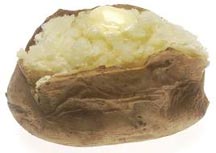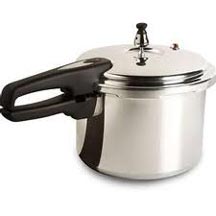Potatoes - 6 Things to Know!
By Alice Osborne
 First, do you ever wonder why your potatoes have a greenish tint to the skin?
First, do you ever wonder why your potatoes have a greenish tint to the skin?
This greenish color occurs when the potatoes have been exposed to natural, artificial, or fluorescent lights. For instance, during growing, cracks in the soil will expose potatoes to sunlight, resulting in the potato turning green.
Also, greening happens a lot more than it used to because supermarkets are open for longer hours so their displays receive more direct light. However, it can also happen at home if you store your potatoes out in the open where they are exposed to light.
The green color on the potato is chlorophyll developing in the skin. Besides the change in skin color, there is also an increased quantity of solanin developing. Solanin is part of the flavoring complex that gives the potato its taste. This is concentrated close to the potato's surface and is easily removed when peeled. Only if the potato has prolonged exposure to light will the bitter taste and color penetrate deeper into the potato.
The Idaho Potato Board recommends that you don't eat the green part of the potato because of its bitter taste. Their advice is to just peel away the green sections before preparing and serving.
 Second, is there a good way to cook potatoes in the microwave?
Second, is there a good way to cook potatoes in the microwave?
Many claim that the microwave actually bakes a more nutritious potato than a conventional oven, because the potato is exposed to nutrient-draining heat for a shorter period of time. The debate on this goes back and forth, but one thing's for sure - there's no debate on the time the microwave saves, so knowing how to successfully cook spuds could be smart. Here's what the Idaho Potato Boards says to do:
• Scrub, dry and prick potatoes with a fork.
• Wrap them in a paper towel and place them one inch apart on a microwave rack.
• Cook according to your oven's guidelines, and turn potatoes once during cooking. (Don't exceed the cooking time, as potatoes will continue to cook after they're removed from the oven.)
HOT POTATO TIP: If you're in a hurry to prepare potatoes but feel that microwaving makes the potato too moist, do this: As soon as you come home from work turn on the oven to 400 degrees F and place the potatoes directly on the rack for about 15 minutes, (just enough time to change out of your work clothes). Then pull out the potatoes and put in the microwave and you'll find that the skin is dry and crispy and the potatoes cook faster. That way you get the taste of oven baking with the speed of microwaving.
 Third, have you wondered what the best baking potato is?
Third, have you wondered what the best baking potato is?
The Burbank Russet is the most well-known baking potato (named after scientist Luther Burbank). The Idaho Potato Boards says a good russet has a rounded, somewhat elongated shape, few and shallow eyes, net-textured skin and a deep brown color. Look for clean, smooth, firm-textured potatoes that have no cuts, bruises or discoloration. Russets have a high solids content, so there's more potato and less water. The high quantity of starch grains cook to a light, fluffy texture; the spud will have a full, firm appearance when properly prepared. Probably the healthiest way to serve your baked potato is with a squeeze of lemon and some salt and pepper. Topping the baked potato with salsa is another good and healthy idea.
And here's something I never knew: You shouldn't use a knife for opening a baked potato; it flattens the surface and alters the normal fluffy texture of a baked spud. Instead, pierce the potato with a fork, once lengthwise and crosswise. Press the potato at both ends and it will "blossom".
 Fourth, what's the best way to cook a potato (if you don't want to bake it or microwave it)?
Fourth, what's the best way to cook a potato (if you don't want to bake it or microwave it)?
Cooking potatoes with the skins on is the best way to preserve the abundant nutrients potatoes naturally possess. And nutritionists say steaming rather than boiling catches even more nutrients. It's also suggested that you save the cooking water after steaming potatoes, as some of the potatoes' nutrients will have leaked into it. Use it to make gravies or bread, to moisten mashed potatoes, or to water houseplants.
And speaking of cooking, what about mashing - do you ever wonder why your mashed potatoes are sticky at times? The Idaho Potato Board says the individual potato cells are susceptible to breaking down based on the amount of starch in the potato. Higher solids (starch) potatoes have larger cell size and tend to not break down as easily when over mixed versus a low solids potato (such as a red or yellow skinned variety) which has smaller potato cells. Among russet varieties, the Russet Burbank usually has the highest solids and lowest moisture, so it tends to turn out dry and fluffy.
 And still speaking of cooking, can a pressure cooker be used to cook potatoes? Absolutely! Use it to get the fastest, easiest, healthiest potato dishes in no time. Imagine mashed potatoes in seven minutes or crunchy topped potatoes in four minutes.
And still speaking of cooking, can a pressure cooker be used to cook potatoes? Absolutely! Use it to get the fastest, easiest, healthiest potato dishes in no time. Imagine mashed potatoes in seven minutes or crunchy topped potatoes in four minutes.
Because foods are cooked under pressure, up to 50% more vitamins and minerals are retained. Since steam pressure breaks down the fibers in food in a very short time, foods are succulent, with an intense mingling of flavors. I'm doing more and more pressure cooking and have even started a chapter in my Cook'n Recipe Software (version 10), "Pressure Cooking Success," that's dedicated to recipes I've tried that we love.
 And fifth, why all the variations in potato sizes - are some better suited for certain things than others?
And fifth, why all the variations in potato sizes - are some better suited for certain things than others?
Well, depending on what you intend to do with the spud really determines the size you want to buy. Small potatoes are best for use in salads, while medium-sized potatoes are quite versatile and can be used baked, mashed or fried. Large ones are ideal for French fries or the "meal-in-itself" baked potato. Whatever size you buy, don't buy potatoes that are soft or have excessive cuts, cracks, bruises or discoloration and decay.
And speaking of buying potatoes, what is the difference between No. 1 and No. 2 potatoes? No. 1 potatoes are typically better shaped with fewer defects than No. 2's. No. 2 potatoes bake and taste the same but may have pointed ends, more bruising, etc. Restaurant operators use No. 2 potatoes when the final appearance or shape doesn't have to be as attractive - for mashed, hash browns or French fries, for example.
 Sixth, what's the best way to store potatoes?
Sixth, what's the best way to store potatoes?
Look them over and use any bruised ones first. And since dampness can cause decay, it is best not to wash spuds before storing - storing them with their caked-on dirt can be messy, but is best for the spud. Don't store spuds in the refrigerator - temperatures are too low, which converts the potato's starch into sugar, resulting in a sweet taste. The extra sugar also causes potatoes to darken prematurely while frying. (This process can sometimes be reversed by storing the potatoes at room temperature for a week to 10 days.)
The best idea is to use a pantry potato bin or some sort of container with air vents that allows air to circulate around the potatoes. Potatoes are still alive when they are picked, so they should be kept in a cool well-ventilated area, away from the light. They will keep about a week at room temperature and for several weeks at 45 degress to 50 degrees F.
 Finally, for more information and some great IDAHO POTATO BOARD tested recipes that you'll want to add to your Cook'n Recipe Software, take a look at IdahoPotato.com.
Finally, for more information and some great IDAHO POTATO BOARD tested recipes that you'll want to add to your Cook'n Recipe Software, take a look at IdahoPotato.com.

